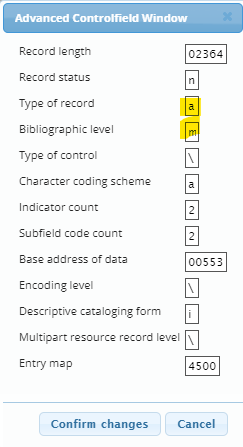New bibliographic record by cloning
TIND offers several ways to create a new bibliographic record in the catalog. This article covers creating a new record by copying an existing record using the "Clone record" function in the Record Editor.
Preliminary records for new acquisitions
In most cases, it is best to start from a Template. This reduces the chances that the new record will carry over incorrect or outdated hidden coding, or that key features will be missing. The exception is cloning from a newly-created preliminary record when other material in the batch is nearly identical (since there is no chance that legacy coding from Voyager will create difficulties).
Make sure that the following MARC fields are correct.
MARC 000 (also known as the "Leader")
Verify data in the two boxes highlighted in yellow. Leave everything else as-is.
- Type of record (this affects the "Narrow by collection" box). If more than one type of material is present, pick the one that predominates. Contact a cataloger if the material doesn't fit one of these categories.
- a = printed text (including printed forms filled in by hand but excluding serials)
- g = movie, tv show, etc.
- k = picture (e.g, engraving, photo, painting)
- r = object (e.g., sculpture, game, souvenir spoon)
- t = manuscript text (not including printed forms filled in by hand)
- Bibliographic level (this affects the "Narrow by collection" box).
- c = collection (any group of intellectually separate items, even if they're together in the same binding, box, or folder)
- m = monograph (any single item or multi-part set, not just books; exception: single volumes containing multiple separate things, such as sammelbands, are coded "c" for "collection").
- s = serial (rarely used for vault material)
MARC 007
Delete if present. (This field triggers a cascade of machine updates that requires cataloger intervention.)
MARC 008
(information to come)
